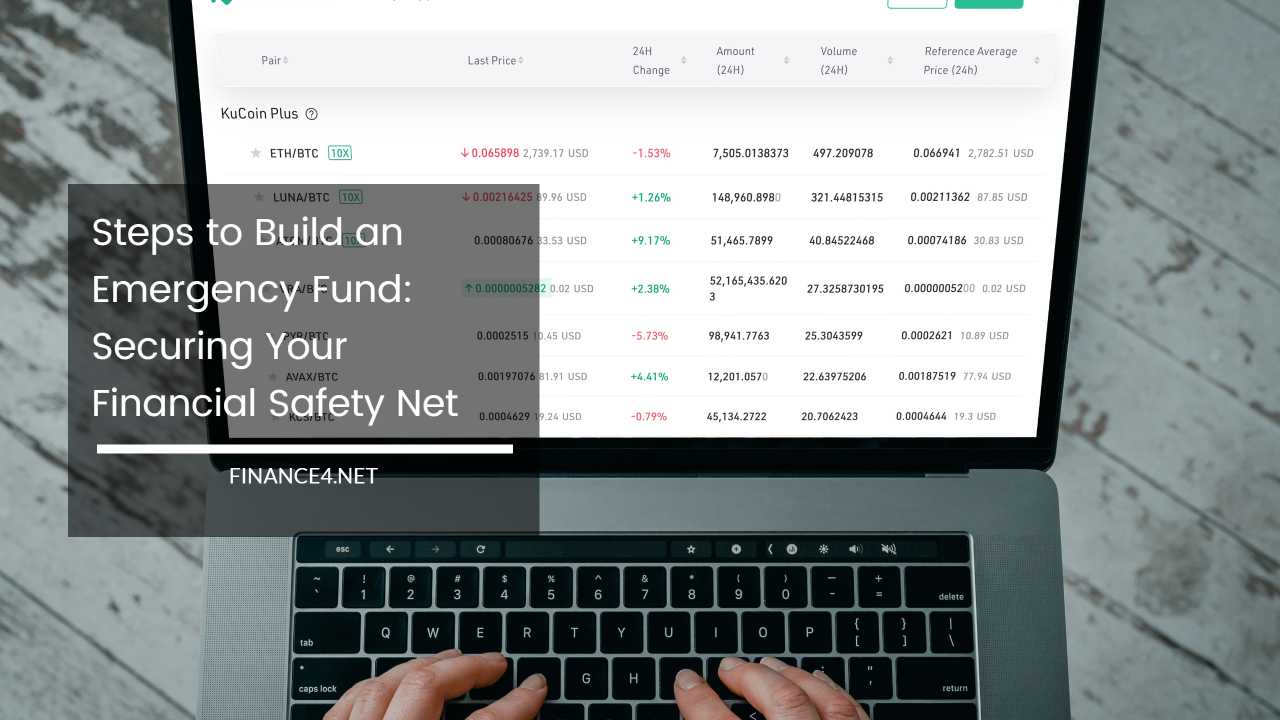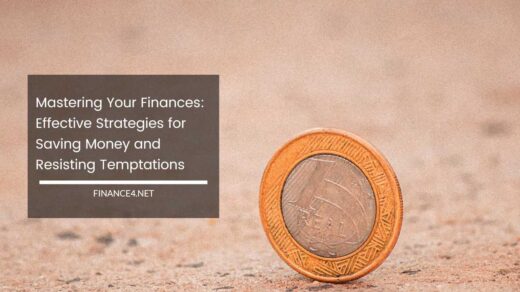Steps to Build an Emergency Fund: Securing Your Financial Safety Net

Build an Emergency Fund
Financial emergencies can strike at any time, and having a well-established emergency fund can provide peace of mind and security during challenging times.
An emergency fund serves as a safety net to cover unexpected expenses, such as medical bills, car repairs, job loss, or home repairs, without resorting to credit cards or loans.
In this comprehensive guide, we will explore the essential steps to build an emergency fund that can protect you from financial hardships and help you achieve long-term financial security.
1. Assess Your Financial Situation
a) Evaluate Your Monthly Expenses:
Start by analyzing your monthly living expenses, including rent or mortgage, utilities, groceries, transportation, insurance, and other necessary expenses.
b) Consider Your Risk Factors:
Take into account your individual circumstances, such as job stability, health status, family responsibilities, and any potential sources of financial support during emergencies.
c) Set Your Emergency Fund Goal:
Determine the target amount for your emergency fund. It is generally recommended to save at least three to six months’ worth of living expenses, but individuals with higher risk factors may aim for up to nine months’ worth.
2. Create a Dedicated Emergency Fund Account
Open a separate savings account specifically designated for your emergency fund. This ensures that the money is not mixed with your regular spending or other savings accounts.
3. Start Small, but Start Now
Begin building your emergency fund by starting with small, regular contributions. Even saving a modest amount each month can add up over time.
4. Set Up Automatic Contributions
Automate your savings by setting up automatic transfers from your checking account to your emergency fund account. This makes saving a consistent amount each month effortless.
5. Reduce Non-Essential Spending
Review your budget and identify areas where you can cut back on non-essential spending. Redirect the money saved from these cutbacks into your emergency fund.
6. Save Windfalls and Bonuses
Whenever you receive unexpected windfalls, such as tax refunds, work bonuses, or monetary gifts, consider directing a portion of these funds into your emergency fund.
7. Consider Additional Income Streams
Explore opportunities for generating extra income, such as taking on a part-time job, freelancing, or selling items you no longer need. Allocate a portion of this extra income to your emergency fund.
8. Avoid Relying on Credit for Emergencies
Having a fully-funded emergency fund allows you to avoid relying on credit cards or loans during emergencies, which can lead to debt accumulation and financial stress.
9. Reassess and Adjust Your Goals
Periodically reassess your emergency fund goal based on changes in your financial situation, family status, or risk factors. Adjust your savings plan accordingly.
10. Celebrate Milestones
Celebrate your progress as you reach various milestones in building your emergency fund. Recognizing your achievements can boost motivation and reinforce positive financial habits.
11. Avoid Using the Fund Unnecessarily
Refrain from using your emergency fund for non-emergencies. The fund should only be accessed during genuine financial emergencies.
12. Replenish the Fund
If you do dip into your emergency fund, prioritize replenishing the withdrawn amount as soon as possible.
13. Stay Committed
Building an emergency fund requires discipline and dedication. Stay committed to your savings plan, knowing that financial security is within reach.
14. Invest Your Fully-Funded Emergency Fund
Once you have reached your emergency fund goal, consider investing the excess funds to potentially earn a higher return. Choose low-risk, easily accessible investment options, such as money market accounts or short-term certificates of deposit (CDs).
15. Reevaluate as Your Financial Situation Evolves
As your financial situation evolves, such as through pay raises, changing expenses, or life events, reassess your emergency fund needs and adjust your savings plan accordingly.
16. Educate Yourself on Financial Management
Continuously educate yourself on financial management and investment strategies to make informed decisions regarding your emergency fund and overall financial health.
17. Maintain Adequate Insurance Coverage
Protect yourself and your assets by maintaining adequate insurance coverage, such as health insurance, homeowner’s or renter’s insurance, and auto insurance.
18. Minimize High-Interest Debt
Focus on reducing high-interest debt, such as credit card balances, to free up more funds for your emergency savings.
19. Establish Other Savings Goals
Once your emergency fund is well-established, consider setting up other savings goals, such as retirement savings, education funds, or travel funds.
20. Seek Professional Financial Advice
If you are uncertain about the best approach to building your emergency fund, consider seeking advice from a qualified financial advisor. They can provide personalized guidance and tailor a strategy to meet your specific needs.
21. Review and Adjust Your Emergency Fund Periodically
Regularly review your emergency fund progress and reassess your financial situation. Life circumstances can change, such as getting married, having children, or experiencing a change in employment. Adjust your emergency fund goal accordingly to ensure it remains aligned with your current needs.
22. Involve Your Family in the Saving Process
If you have a family, involve them in the process of building the emergency fund. Educate them about the importance of financial preparedness and encourage them to contribute to the fund if possible.
23. Use Windfalls Wisely
Windfalls, such as inheritances or lottery winnings, can be tempting to splurge on. Instead, use these unexpected funds wisely by directing a significant portion towards your emergency fund.
24. Prioritize High-Interest Debt Repayment
High-interest debt, such as credit card debt or payday loans, can quickly accumulate and hinder your ability to save for emergencies. Prioritize paying off these debts to free up more funds for your emergency savings.
25. Keep Your Emergency Fund Liquid
Ensure that your emergency fund is easily accessible and liquid. While investing excess funds can provide higher returns, it’s essential to keep the majority of your emergency fund in a savings account or other low-risk, easily accessible accounts.
26. Maintain Discipline During Financial Windfalls
Financial windfalls, such as a bonus at work or a tax refund, can be tempting to spend on non-essential items. Stay disciplined and allocate a portion of these funds to your emergency fund.
27. Take Advantage of Employer Benefits
Some employers offer matching contributions to retirement or savings accounts. If available, take advantage of these benefits to boost your emergency fund contributions.
28. Educate Yourself on Emergency Fund Uses
Understand the appropriate uses of your emergency fund. It should be used for genuine emergencies, such as unexpected medical expenses, urgent car repairs, or temporary job loss, and not for discretionary expenses or non-urgent wants.
29. Protect Your Income
Consider purchasing disability insurance to protect your income in the event of a debilitating illness or injury. This insurance can provide you with an additional layer of financial security.
30. Celebrate Milestones with Smart Spending
When you achieve significant milestones in building your emergency fund, celebrate with a small treat or outing. However, avoid overspending and maintain your commitment to saving.
31. Teach Financial Preparedness to Children
Educate your children about the importance of financial preparedness and saving for emergencies. Teaching them early about sound financial habits can set them up for a successful financial future.
32. Prepare for Job Transitions
If you anticipate a job transition, such as changing careers or starting a business, ensure that your emergency fund is adequately funded to provide support during potential periods of reduced income.
33. Keep an Eye on Inflation
As inflation can erode the purchasing power of your savings over time, consider adjusting your emergency fund goal to account for inflationary pressures.
34. Stay Positive and Stay on Track
Building an emergency fund takes time and dedication. Stay positive about your progress and stay on track with your savings plan, knowing that financial security is a valuable investment in your future.
35. Celebrate Financial Independence
Achieving a fully-funded emergency fund can provide you with financial independence and security. Celebrate this milestone as a significant achievement in your journey towards financial well-being.
Final Thoughts
Building an emergency fund is a critical step in achieving financial security and peace of mind.
By following these comprehensive steps and maintaining discipline and consistency in your savings plan, you can gradually build a robust emergency fund that protects you and your loved ones during challenging times.
Keep in mind that building an emergency fund is an ongoing process, and periodically reassessing your financial goals will ensure that your fund remains adequate for your evolving needs.
Stay committed to financial preparedness, and you will be well-prepared to face life’s uncertainties with confidence.



